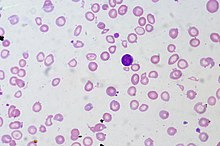|
Dyserythropoiesis
Dyserythropoiesis refers to the defective development of red blood cells, also called erythrocytes.[1] This problem can be congenital, acquired, or inherited.[2] Some red blood cells may be destroyed within the bone marrow during the maturation process, whereas others can enter the circulation with abnormalities.[3] These abnormalities can be functional and/or morphological, which can lead to anemia since there may be increased turnover of red blood cells.[1][2] There are a number of diseases that cause dyserythropoiesis. Congenital/inherited causes include congenital dyserythropoietic anemia, thalassemia, pyruvate kinase deficiency, hereditary pyropoikilocytosis, and abetalipoproteinemia.[2] Acquired causes include nutrient deficiency/malnutrition (e.g. cobalamine, folate, and iron), myelodysplasia, HIV infection, and certain medications (e.g. zidovudine).[2] See alsoReferences
|
||||||
